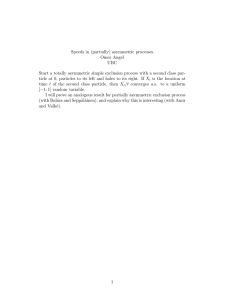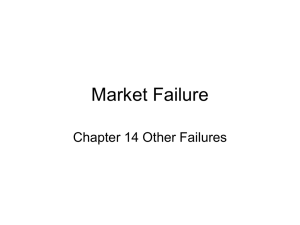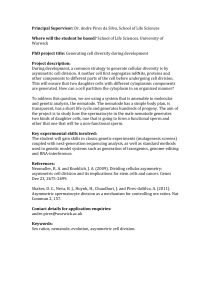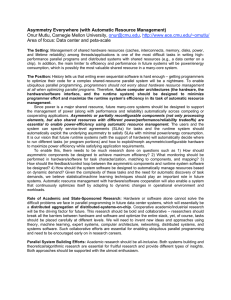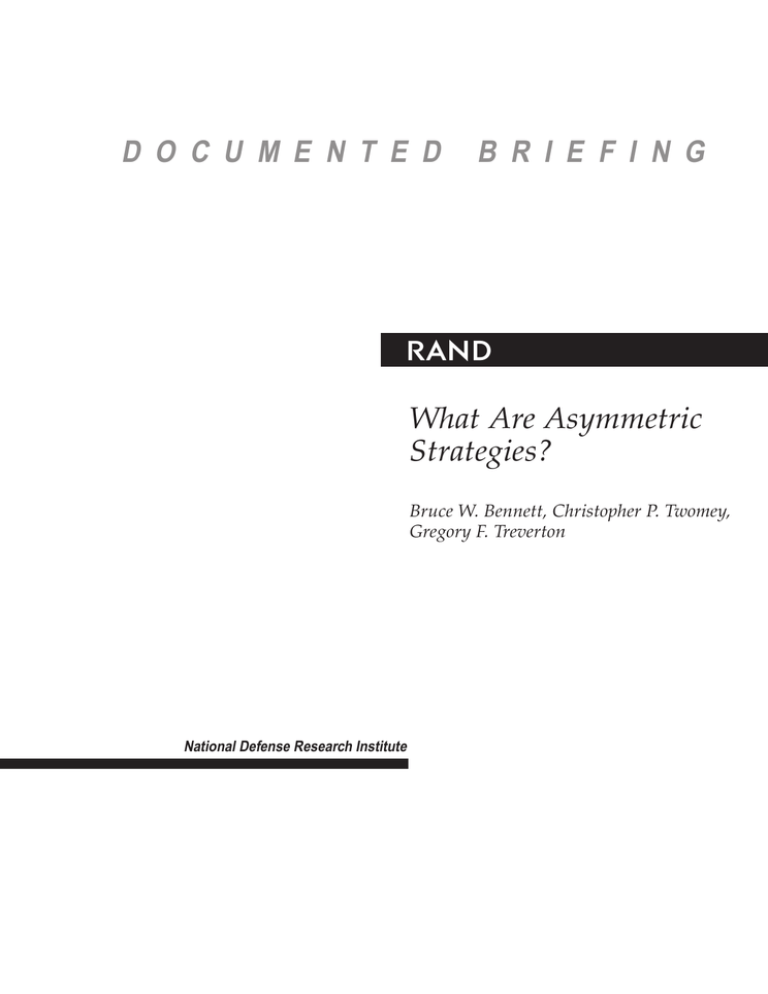
D O C U M E N T E D
B R I E F I N G
R
What Are Asymmetric
Strategies?
Bruce W. Bennett, Christopher P. Twomey,
Gregory F. Treverton
National Defense Research Institute
The research described in this report was sponsored by the Office of the Secretary of
Defense (OSD). The research was conducted in RAND’s National Defense Research
Institute, a federally funded research and development center supported by the OSD,
the Joint Staff, the unified commands, and the defense agencies under Contract
DASW01-95-C-0059.
ISBN: 0-8330-2703-4
The RAND documented briefing series is a mechanism for timely, easy-to-read
reporting of research that has been briefed to the client and possibly to other
audiences. Although documented briefings have been formally reviewed, they are
not expected to be comprehensive or definitive. In many cases, they represent interim
work.
RAND is a nonprofit institution that helps improve policy and decisionmaking
through research and analysis. RAND ® is a registered trademark. RAND’s
publications do not necessarily reflect the opinions or policies of its research sponsors.
© Copyright 1999 RAND
All rights reserved. No part of this book may be reproduced in any form by any
electronic or mechanical means (including photocopying, recording, or information
storage and retrieval) without permission in writing from RAND.
Published 1999 by RAND
1700 Main Street, P.O. Box 2138, Santa Monica, CA 90407-2138
1333 H St., N.W., Washington, D.C. 20005-4707
RAND URL: http://www.rand.org/
To order RAND documents or to obtain additional information, contact Distribution
Services: Telephone: (310) 451-7002; Fax: (310) 451-6915; Internet: order@rand.org
D O C U M E N T E D
B R I E F I N G
R
What Are Asymmetric
Strategies?
Bruce W. Bennett, Christopher P. Twomey,
Gregory F. Treverton
Prepared for the
Office of the Secretary of Defense
National Defense Research Institute
Approved for public release; distribution unlimited
- iii -
PREFACE
This briefing presents an abbreviated description of RAND’s work on asymmetric
strategies done in support of the 1997 Quadrennial Defense Review. It describes asymmetric
strategies, why they matter in defense planning, and how they may affect future U.S. military
activities. Adversaries will likely choose asymmetric strategies in future conflicts because
emulating U.S. military force structure and its related strategy is too expensive for other
countries, forcing prospective adversaries to pursue different approaches to confrontation.
Adversary asymmetric strategies will target U.S. vulnerabilities rather than directly attacking
U.S. strengths.
This research effort was sponsored by the Assistant Secretary of Defense for Strategy and
Threat Reduction. It was performed within the International Security and Defense Policy Center
of RAND’s National Defense Research Institute, a federally funded research and development
center sponsored by the Office of the Secretary of Defense, the Joint Staff, the unified commands,
and the defense agencies.
Comments and inquiries are welcome and should be addressed to the principal author.
-v-
CONTENTS
Preface ................................................................ iii
Summary ..............................................................vii
Acknowledgments........................................................ ix
Abbreviations ........................................................... xi
1. WHAT ARE ASYMMETRIC STRATEGIES? ....................................1
2. COUNTERING ASYMMETRIC STRATEGIES.................................. 11
3. SUMMARY........................................................... 13
- vii -
SUMMARY
The 1997 Quadrennial Defense Review (QDR) evaluated future U.S. strategy and force
structure. It paid particular attention to a set of threats referred to as asymmetric challenges or
asymmetric means. This documented briefing provides a brief description of the asymmetric
strategies that employ these challenges.
Today, U.S. forces appear capable of defeating the normally postulated military threats,
including those associated with major theater wars. But many of these postulated threats are
relatively symmetric in character, directly seeking to combat U.S. strengths. Future adversaries
appear more likely to attack U.S. vulnerabilities and to do so using largely asymmetric means, in
part because they cannot afford military forces and capabilities comparable to those of the United
States.
This concept is not new; much of military history and theory focuses on asymmetric
challenges. For various reasons explained herein, the United States often fails to appreciate these
threats and therefore does not adequately prepare for them. In modern warfare, the performance
of U.S. forces could be substantially degraded if they are faced with threats for which they are
inadequately prepared (lacking the needed doctrine, operational concepts, military R&D and
acquisitions, force structure and force posture, and/or training). While U.S. doctrine as
explained in Joint Vision 2010 calls for “full-dimensional protection” of U.S. forces, such
protection is extremely expensive and does not presently exist.
It seems likely that asymmetric strategies will dominate the threats posed by U.S.
adversaries in the foreseeable future. Therefore, understanding these threats and responses to
them is fundamental to U.S. military strategy and planning for the future.
The goal of this project was primarily to characterize asymmetric threats as a first stage in
helping U.S. leaders to recognize them, and only secondarily to suggest U.S. responses. A followon research effort is currently pursuing U.S. means for countering these threats according to an
approach outlined herein.
- ix -
ACKNOWLEDGMENTS
This work was done under the direction of Andy Hoehn, the Principal Director for
Strategy, and Michele Flournoy, the Deputy Assistant Secretary for Strategy under the Assistant
Secretary of Defense, Strategy and Threat Reduction, Dr. Ted Warner. The authors are grateful
for the guidance, suggestions, and support of Andy, Michele, and Ted, and members of their
staff: Bob Scher; Lieutenant Colonel Bill Roege, USAF; Kathleen Hicks; Matt Russell; and Captain
Joe Klingseis, USN.
- xi -
ABBREVIATIONS
AWACS Airborne Warning and Control System
BW Biological weapons
CBW Chemical and biological weapons
CONOPs Concepts of operation
CW Chemical weapons
DoD Department of Defense
DSP Defense Support Program
IDF Israeli Defense Force
IW Information warfare
LOCs Lines of communication
MOPP Mission-oriented protective posture
MTW Major theater war
QDR Quadrennial Defense Review
RMA Revolution in military affairs
SAM Surface-to-air missile
SOF Special Operations Forces
SWORD Short-range air defense with optimized radar distribution
TBM Theater ballistic missile
THAAD Theater High-Altitude Area Defense
TM Theater missile
UN United Nations
WW I World War I
What Are Asymmetric Strategies?
Bruce Bennett
September 1998
Asymmetric Strategies-1
Legislation for the 1997 Quadrennial Defense Review (QDR) required that it
identify the threats faced by the United States and evaluate future U.S.
strategy and force structure. The QDR discussed the concept of “asymmetric
challenges” or “asymmetric means” as a major thrust of future threats.*
In an era when U.S. forces appear dominant across a range of potential
conflicts, many observers question whether serious threats still exist. But U.S.
dominance generally exists against relatively symmetric threats, where
adversaries seek to directly combat U.S. strengths. It seems more likely that
future adversaries will seek to attack U.S. vulnerabilities using strategies
different from the standard U.S. strategies. We refer to such threats as
asymmetric strategies.**
* See William S. Cohen, Report of the Quadrennial Defense Review, Department of Defense, May
1997, in particular pp. 4 and 49–51, but also pp. vii, 12, 13, 19, 41, and 43.
** RAND’s work on asymmetric strategies in support of the QDR is documented in Bruce W.
Bennett, Christopher P. Twomey, and Gregory F. Treverton, Future Warfare Scenarios and
Asymmetric Threats, RAND, MR-1025-OSD, 1998. RAND’s earlier work on asymmetric
challenges included: Bruce W. Bennett, Sam Gardiner, Daniel B. Fox, and Nicholas K. J.
Witney, Theater Analysis and Modeling in an Era of Uncertainty: The Present and Future of
Warfare, RAND, MR-380-NA, 1994; unpublished RAND research by Sam Gardiner and Dan
Fox on “Understanding Revolutions in Military Affairs”, and by Ken Watman on
“Asymmetric Strategies for MRCs.” RAND, unpublished, 1995.
1
Providing a Context for the Concept
The U.S. military inadequately appreciates some threats
•
And some of these are serious and expanding (e.g., CBW)
Without appreciating threats, preparation is difficult
•
•
And, in modern warfare, preparation is essential (otherwise you
are generally stuck responding rather than preventing)
Threats are a major basis for
− Training, doctrine, and operational concepts
− Military R&D and acquisitions, force structure, force posture
Most unappreciated threats are asymmetric in nature
The threats’ asymmetry itself is a major contributor in
explaining why the U.S. has not appreciated them
Asymmetric Strategies-2
In the post–Cold War era, the United States faces a range of threats. Many it
understands and prepares for well. The difficulty with adversary use of
asymmetric challenges occurs when the United States and its military leaders
in particular fail to fully appreciate these challenges.
Prospective U.S. adversaries are actively carrying out information denial to
prevent the United States from understanding their efforts. Such countries as
Iraq and North Korea have made it difficult for the United States to identify
many of the key weapons on which they are working, let alone their strategy
and concepts of operation (CONOPs). For example, which kinds of and how
much chemical and biological weapons (CBW) have Iraq or North Korea
produced, where are they stored, and how would they be used?
The importance of appreciating asymmetric challenges comes from the fact
that modern warfare demands preparation. Training, doctrine, CONOPs,
military research and development (R&D) and acquisitions, force structure,
and force posture are all affected in a major way by threat assessments.
Threats must be appreciated well before they are mature so that preparations
can be completed to counter the threats, especially in a fiscally constrained
environment.
For example, only since early 1997 has the CBW threat been better
appreciated. It will take years for the United States to prepare well for the
CBW threat, leaving the United States and its allies vulnerable over that time
and requiring the development of new U.S. strategies and CONOPs to
minimize this vulnerability.
Most unappreciated threats are asymmetric in nature. Indeed, the asymmetric
character of such threats contributes to their not being appreciated.
2
Defining Asymmetric Strategies
Asymmetric strategies attack vulnerabilities not appreciated
by the target or capitalize on limited preparation against the
threat
1) They rely primarily on concepts of operations fundamentally
different from those of the target and/or from those of recent
history—often employing different weapons—and/or
2) Can serve political or strategic objectives substantively
different from those the target pursues
Nonvital interests are very vulnerable to asymmetric threats
•
•
Threats can focus on will, not defeating the military in detail
The will threshold can be low (e.g., Beirut or Mogadishu)
The essence of asymmetric strategy is not new
•
Sun Tzu, maneuver warfare, centers of gravity, etc.
Asymmetric Strategies-3
Asymmetric strategies attack vulnerabilities not appreciated by the “target”
(victim) or capitalize on the victim’s limited preparation against the threat.
These strategies rely (primarily, but not exclusively) on CONOPs that are
fundamentally different from the victim’s and/or from those of recent history.
They often employ new or different weapons. Additionally, they can serve
political or strategic objectives that are not the same as those the victim
pursues. It is important to recognize that symmetric and asymmetric
strategies are defined in relative terms: Some strategies are more asymmetric
than others.
For an asymmetric challenge to be threatening, it must target a key
vulnerability or dependency of the victim. Because U.S. military actions today
usually support less-than-vital interests, adversaries can threaten the will or
commitment of the United States and its allies rather than having to defeat
U.S. military forces in detail. Indeed, when U.S. interests are limited, an
adversary threat need impose only a modest cost to defeat U.S. will (as in
Beirut or Mogadishu), opening a wider diversity of strategies to an adversary.
Targeting key vulnerabilities is not unique to the concept of asymmetric
strategies; comparable historical concepts have included: the writings of Sun
Tzu, maneuver warfare, and centers of gravity.
For example, airpower is a U.S. center of gravity in almost any U.S. and allied
operation. Most prospective U.S. adversaries cannot field air forces adequate
to counter U.S. air forces: They cannot afford to symmetrically challenge U.S.
airpower air-to-air. Instead, they field surface-to-air missiles and air defense
artillery as their primary form of air defense; the United States fields similar
systems but anticipates countering most adversary air forces in an air-to-air
3
mode first; U.S. air defense systems are normally perceived as a backup rather
than a primary defense, a modest asymmetry. North Korea apparently
believes that the best way to counter U.S. and allied air forces is to use Scud
missiles to deliver persistent chemical weapons to theater air bases, disrupting
sortie generation. While the United States has also emphasized air base attack,
this approach is very asymmetric, relying on both weapons and delivery
systems different from what the United States would consider using for air
base attack and causing both operational and strategic effects (including a
high possibility of inducing U.S. retaliation) different from what the United
States would seek to cause.
4
Examples Along the Continuum
CONOPs (target is U.S. military):
Arty Duel
Inf vs.
Inf
SOF
attacks
on
AWACS
IW on
military
targets
Flanking
Maneuvers
Symmetric
Armor vs.
Combined Force
SOF
attacks
on rear
area
depots
Scud CW
attacks
on
airfields
IW on
civilian
targets
Coercive
BW
attacks
on US
allies’
citizens
Asymmetric
Terrorism
aimed at
coercion
Historical Battles:
Pusan Perimeter
Gettysburg
Symmetric
Battle of the Bulge
U-Boats, WW I
Grozny
Asymmetric
CONOPs
Korea, 1950
Symmetric
Battle of Ardennes
Fulda Gap
(presumed)
Cold War
Somalia
Political/Strategic Objective
Tet
‘73 War
Asymmetric
Asymmetric Strategies-4
As the examples on this chart suggest, relatively few CONOPs and battles are
purely asymmetric; most involve a mixture of symmetry and asymmetry. Yet
the more asymmetric the challenge, the less likely the country facing the
challenge is or has been to appreciate it, at least until it is surprised by the
challenge (which is often too late for an effective response).
Note that asymmetries in political/strategic objectives also matter. For
example, in the Yom Kippur War of 1973, the Israelis discounted the
possibility of an Egyptian attack because they viewed Egyptian goals
symmetrically, assuming that total control of the Suez Peninsula was all that
mattered, and thus Egypt had no prospect for victory. Two months before the
Egyptian surprise attack, Israeli Defense Minister Moshe Dayan stated to the
Israeli Staff College: “The balance of forces is so much in our favor that it
neutralized the Arab considerations and motives for the immediate renewal of
hostilities.” The Egyptians goals were asymmetric: “Firm Egyptian military
control of a substantial strip of territory on the east bank of the Canal would
be deemed a success.” In this context, the Egyptian buildup of the late
summer west of the Suez and deployment of SAM systems and large numbers
of infantry-borne antitank missiles all should have been quite threatening to
Israel. Had Egypt’s strategic goals been understood in Tel Aviv, its tactical
and operational moves could have been appreciated and more effectively
countered.*
* For a good summary of this war, see Col. Trevor Dupuy, ret., Elusive Victory: The Arab-Israeli
Wars, 1947-74, 3rd Edition, Dubuque, Iowa: Kendall/Hunt Publishing Company (1991), pp.
387–618. The quotes are from pages 406 and 390, respectively.
5
Asymmetric Challenges Are Useful in
All Phases of Major Theater Wars
From an adversary’s perspective, key phases
include
•
Prewar coercion and other efforts vs.
U.S., allies
•
Disrupting U.S./allied force generation
and deployments
•
Capturing territorial objectives
•
Preventing a counteroffensive
•
Winning the long-term peace
Aerospace/
Maritime
Superiority
XX
2
XXX
3
Counteroffensive
Pusan
x
Power Projection
Logistics
Asymmetric challenges will be used
across these phases, but especially early
to prevent U.S. strategy implementation
and achieve rapid or preemptive success
x
Allied Support
Dhahran
Forward
Presence
U.S./Allied
Will/Commitment
Asymmetric Strategies-6
Asymmetric challenges can be applied across the phases of major theater wars
or smaller-scale contingencies. Several prospective U.S. adversaries carry out
significant peacetime information campaigns today (for example, Saddam
Hussein’s efforts to deny the United States partners and access in the Persian
Gulf by arguing that the U.S.-led UN sanctions against Iraq are killing
thousands of innocent Arabs). Military preparations by prospective
adversaries suggest that they are positioning themselves to carry out
asymmetric threats that would jeopardize U.S. force flows and warfighting
plans. Most adversaries require such facilitating CONOPs to offset U.S.
advantages and give them a chance for success.
Most U.S. adversaries would prefer to prevent U.S. intervention because
without that intervention they will likely succeed; fighting and defeating the
United States is clearly a poor alternative. To prevent U.S. intervention,
adversaries will likely apply asymmetric challenges in peacetime, in a crisis,
and very early in a conflict. Such challenges would attack U.S. willpower or
significantly disrupt U.S. planning, causing a U.S. strategic pause or
convincing the United States to disengage. For example, a lack of regional
access for U.S. forces might impair U.S. capabilities to conduct a campaign. Or
the United States may not be able to deploy its forces as planned if there is an
early loss of host nation support, such as dock workers, stemming from CBW
strikes or the threats thereof.
The United States can expect adversaries to oppose a counteroffensive using
asymmetric threats. Especially for North Korea, the planned U.S./allied
counteroffensive would threaten the survival of the adversary regime, causing
the adversary to threaten or use the worst weapons available (e.g., BW).
6
Other Characteristics of Asymmetric Threats
• Symmetric strategies and CONOPs are common because
− The strengths of these strategies are understood and proven
− Militaries are more comfortable preparing to “fight the last war”
− They appear less risky
• Asymmetric
CONOPs are more
difficult to prepare
Key Weapons Today
• CBW
− More risky, usually require innovation
• Theater missiles
− Hard to penetrate adversary innovation • Info warfare
cloaked in secrecy
• Thus,
the U.S. should study them
•Adv. SAMs
•SOF, terrorism
•Deep-sea mines
• Adv. diesel subs
Few asymmetric CONOPs are “silver bullets” in MTWs
• They may play the dominant role for limited attacks
• They will be used with other elements of adversary strategy
• A synergy of asymmetric efforts may prove decisive in major conflicts
But a single asymmetric act may be a “silver bullet” against
less-than-vital interests
Asymmetric Strategies-7
Some might argue that our definition of asymmetric threats seems allencompassing, from a U.S. perspective, including everything outside of a
rather small set of U.S. strategies or those recently practiced. However, this
view confuses the number of theoretically possible strategies with the number
of strategies actually practiced. The vast majority of strategies actually
practiced are relatively symmetric for several reasons. The strengths and
weaknesses of symmetric strategies and related CONOPs are well understood.
Militaries are usually more comfortable preparing to “fight the last war.”
Innovation is invariably risky; these risks provide significant incentives to use
symmetric approaches. For these reasons, relatively symmetric strategies
have tended to be more commonly practiced.
While weapons are not the essence of asymmetry, several weapon systems are
consistently seen as part of adversary asymmetric strategies because these
weapons are capable of threatening U.S. forces and (in some cases) U.S.
society. These weapons include CBW, theater missiles, special forces,
terrorism, advanced surface-to-air missiles (SAMs), deep-sea mines, diesel
submarines, and information warfare.
In MTWs, any given asymmetric challenge will usually not prove to be a
“silver bullet” that defeats U.S. military power, but a combination of such
challenges, in particular the synergies those challenges achieve if the United
States is unprepared for them, is likely the best bet an adversary has in a
military confrontation with the United States. But in cases where the U.S.
interests are far from vital, even a single asymmetric act may be sufficient to
defeat U.S. will, as happened in Beirut with the bombing of the Marine
barracks.
7
Some Potential Future Asymmetric Threats
Strategic actions
• Affecting perceptions (e.g., Saddam Hussein manipulating UN
sanctions—Arab states deny U.S. access)
• Coercion (e.g., a BW threat to Riyadh or New York)
• Disruption (e.g., hacker strikes on DoD computers)
• Destruction (e.g., a BW attack on New York)
• Exhaustion (e.g., Vietnam)
• Strategic event (e.g., Beirut bombing or Mogadishu raid)
Operational actions
• Military/economic denial (e.g., mines in the Strait of Hormuz)
• Military disruption (e.g., a CW attack on airfields or ports; SOF
attack on ground LOCs)
• Political/economic disruption (e.g., terrorism; trade interdiction)
Asymmetric Strategies-8
What kinds of asymmetric threats might the United States face in the future?
Adversaries could consider a wide range of threats, some of which, such as
affecting international perceptions and creating strategic events, are ongoing
or have happened within recent memory. Other threats have not yet
happened and some are not very likely (e.g., attacks that cause massive
destruction within the United States), though none can be completely ruled
out. The threats can be posed against U.S. military capabilities (e.g., the threat
of CW attacks on military airfields), political and economic interests (e.g.,
terrorism), or some combination (e.g., mines in the Strait of Hormuz), and
many threats may be more strategic in character, bringing the implications of
regional conflicts home to the United States rather than leaving such conflicts
in a theater thousands of miles away. Adversaries do need to worry that
attacks on the United States could backfire and lead to serious U.S. escalation.
Surprise in one form or another will often play a role. Strategically, likely
adversary coercive and limited scenarios rely fundamentally on the ability of
the adversary to present the United States with a fait accompli. Tactically,
adversaries may also achieve key surprises (e.g., a mine hit on a warship or
civilian oil tanker).
Many asymmetric strategies also target the long-term international
competition. For example, the status of being a “WMD state” provides
adversaries with coercive leverage, and compels the United States to address
full-dimensional protection more seriously, raising the costs of foreign
involvement. In general, these effects are to the detriment of the United States
and its interests.
8
Why Might the United States Be
Underprepared for Asymmetric Threats?
1. Lack of strategic appreciation
−
•
E.g., CBW threat in Korea
before 1997
•
2. Lack of tactical/operational
appreciation
−
•
E.g., not knowing how
terrorists would strike Khobar
Towers
When intelligence is lacking, cognitive
biases push individuals to “mirror image”
Organizational theory: large
bureaucracies have trouble “thinking
outside of the box,” changing
Resource constraints can create strategic
myopia
− To the benefit of other priorities—e.g.,
fighter acquisition
3. Time lag for implementing responses given appreciation
− E.g., CW threat in Korea over next several years
4. Preparation may be inherently difficult
− E.g., counterterrorism (even if willing to spend money, make sacrifices)
Asymmetric Strategies-9
During the Cold War, military analysis and policy were dominated by highend, relatively symmetric threats (strategic nuclear and NATO Central Front).
Most analysts were trained to think in such symmetric terms and find it
difficult now to adapt to asymmetric challenges. Specifically, asymmetric
threats challenge U.S. thinking for several reasons: a lack of strategic
appreciation (e.g., the CBW threat in Korea before 1997); a lack of
tactical/operational appreciation (e.g., knowing terrorism is a threat in Saudi
Arabia but not knowing where, when, and how terrorists would strike Khobar
Towers); the time lag for implementing responses given appreciation (e.g., the
CW threat in Korea since 1997); and inherent difficulty of preparation (e.g.,
countering all terrorism, even if the United States were willing to spend
money and make other sacrifices, would be problematic).
These problems could exist for symmetric or asymmetric threats. However,
three factors make these types of underpreparation (and the first two, in
particular) more likely in cases of asymmetric threats. First, when intelligence
on adversary strategy and CONOPs is lacking (as it commonly is for
prospective U.S. adversaries), cognitive biases push individuals to “mirror
image.” This will lead them to overlook or discount asymmetric possibilities.
Second, organizational theory suggests that large bureaucracies have trouble
“thinking outside of the box,” changing “standard operating procedures” and
perceptions. These group biases both decrease the chance that an organization
will recognize an asymmetric threat and stifle the degree to which it can
evaluate the range of effects that could be caused by an asymmetric threat.
Finally, resource constraints can create strategic myopia, allowing other
priorities (e.g., acquisition of fighter aircraft or destroyers or artillery) to
receive more attention.
9
Asymmetric Threats: More Dangerous Today?
(not conceptually new, but, in practice, increasingly dangerous)
Adversaries are more likely to choose asymmetric strategies
•
Nations emulate successful strategies, but U.S. strategy is too expensive
Proliferation of specific, powerful technologies
•
Creates coercive possibilities even for poor adversaries (WMD, TM, IW)
The end of the Cold War
•
High-end, relative symmetric challenges had dominated
•
Increase of U.S. intervention abroad, no chance of alt. superpower patron
•
Less-than-vital U.S. interest, high interest for the adversary
Changes in the “nature of warfare”
•
U.S. reliance on RMA creates dependencies/vulnerabilities
•
Shorter wars (due to tech., size of mil.) means preparation more important
Asymmetric Strategies-10
Adversaries are more likely to use asymmetric threats against the United
States in the future than they have been in the past. While nations normally
emulate successful strategies, the U.S. strategy is too expensive. Instead,
adversaries must strive to overcome biases against innovation and search for
affordable, viable asymmetric alternatives. The proliferation of CBW, theater
missiles, and other advanced weapons provides a variety of new tactical and
coercive possibilities that can be very effective even for poor adversaries. In
short, adversaries will have both the motives and the means for testing
innovation to deter or defeat U.S. actions.
Many analysts trained during the Cold War are tempted to focus on
symmetric threats, which still exist in the militaries of most prospective
adversaries but tend not to be significant. The end of the Cold War has also
removed the prospect of an alternative superpower patron for adversaries and
increased the frequency with which the United States intervenes abroad. In
the post–Cold War era, the United States has become relatively safe, while its
potential adversaries feel (increasingly) threatened. Attacks against the
United States are becoming very tempting, especially using deniable terrorism
as an asymmetric threat.
The incorporation of information revolution technologies into the military not
only enhances U.S. capabilities substantially, but also adds new dependencies
(especially in the context of substantial force structure drawdowns). These
new technologies create potentially valuable targets for asymmetric strategies.
Additionally, some argue that the pace of war has quickened. This will put a
premium on preparation, and as argued above, preparation is particularly
difficult against asymmetric threats.
10
General Approaches for Countering
Asymmetric Strategies
• Use shaping strategies to dissuade, deter, and deny threats
– Information operations key to dissuade and deter
– Enhance deterrence with new escalation control concepts
• Enhance intelligence, assuming the adversary perspective
– Need enhanced strategic surveillance, innovative evaluation
– Reduce surprise and allow preparation and early responses
• Seek robust, innovative counters
– Use U.S. asymmetric strengths and reduce U.S. vulnerabilities
– Develop specific counters
– Package forces for full-dimensional protection
– Limit military commitments to more vital U.S. interests
Asymmetric Strategies-11
Countering Asymmetric Strategies
The United States cannot afford to fully protect itself against the diverse range
of prospective asymmetric challenges and thus needs to develop a shaping
strategy to address them. This strategy would seek to dissuade adversaries
from developing asymmetric threats, to deter adversaries from using already
developed threats, and to deny their ability to employ the remaining threats
effectively. An aggressive information operations campaign is needed to
achieve these shaping outcomes, with particular emphasis on peacetime
engagement. Deterrence will also require the United States to reinvigorate its
deterrence logic and establish new concepts for escalation control.
A shaping strategy must rely on U.S. intelligence to improve its ability to
recognize and appreciate asymmetric challenges. Doing so requires more
extensive strategic surveillance and an innovative approach that develops
reasonable evaluations of adversary strategies from its perspective. Good
intelligence reduces the probability of surprise and should give the United
States time to respond to many adversary preparations.
Once the range and likelihood of potential adversary threats have been
identified, the United States needs to develop a robust and innovative set of
counters that neutralizes key threats and gives the initiative to U.S. and allied
forces. These counters must reduce U.S. vulnerabilities and will likely draw
on U.S. asymmetric strengths. Some counters will be specific to the threats
(e.g., vaccines countering BW), though improved force packaging is a general
requirement for full-dimensional protection. The United States must also limit
its foreign military commitments that do not represent vital interests, while
actively and publicly making the case for what constitutes vital interests.
11
Full-Dimensional Protection:
Forward Deploying an Air Wing
Situational
Awareness
Air, Cruise Missile Threat:
IW Threat:
TBM Threat:
• DSP, ...
• Aegis, Counterforce
• Patriots, SM-2 IVa, ...
• ABL, THAAD, ...
• Surveillance
• Info security
• Counter-IW
• AWACS, ground radars,
aerostat
• Fighter intercept
• Avenger, THEL, SWORD
HQ
CBW Threat:
• MOPP
• Collective protection
• Decontamination
• CONOPs
• Medical
SOF Threat:
• Surveillance, intel
• Perimeter security
• Mobile strike teams
Sustainment and
support requirements
Asymmetric Strategies-12
In seeking to reduce its vulnerabilities, the United States should move toward
deploying modules of full-dimensionally protected forces rather than using a
piecemeal approach.* For example, forward-deployed forces should be
supported by CBW protection, missile defenses, capable security forces that
cover the base area and well beyond, and so forth. In crisis or conflict as
forces deploy abroad, they should bring with them (or even be preceded by)
similar defenses. The United States provides some elements of protection
with every force it deploys overseas, but full-dimensional protection is not
adequately understood today, let alone practiced by the U.S. military.
The cost of such protection is high and may force the United States to increase
the size of its military, reduce its foreign commitments (consistent with the
argument above that the United States needs to focus on more-vital interests),
or rely more on the revolution in military affairs. The cost of protection may
tempt the United States to respond only to threats that intelligence indicates
adversaries are actively pursuing. This view may be reasonable in the short
term and could establish short-term protection priorities, but in the long term
will only tempt adversaries to adapt their capabilities to threaten residual
vulnerabilities. U.S. choices for preparation will affect the threats it faces, and
unless U.S. intelligence on such evolving threats is superlative, the United
States is likely better off taking at least some protective actions preemptively
against each of the range of possible threats in order to deter adversary
challenges.
* Full-dimensional protection is one of the key operational concepts in Joint Vision 2010, U.S.
Joint Chiefs of Staff, 1996.
12
Summary
•
•
•
U.S. can expect asymmetric strategies because
− Given U.S. conventional superiority, symmetric competition
is too costly for adversaries
− Proliferation, post–Cold War era, and RMA create both
opportunities and incentives for adversary asymmetries
Adversary asymmetric strategies can change the way future
campaigns are fought
− Fundamentally disrupting or impairing U.S. strengths
− Some threats will be so serious that the U.S. must deter
them, not get involved, or prepare for early disengagement
U.S. responses require innovation, serious study
− Identify key adversary strategy options
− Address U.S. centers of gravity, other vulnerabilities
− Use shaping strategy to dissuade, deter, and deny
− Consider implications for force structure and posture, force
protection, military commitments
Asymmetric Strategies-13
Summary
In many ways, U.S. ascendancy to conventional military superiority provides
the major incentive for adversaries to pursue asymmetric challenges. Other
changes in military and technological affairs provide further incentives.
Adversary asymmetric threats will likely change the course of future wars and
change the attributes of military forces that will lead to success in those
campaigns. The United States must prepare to deal with asymmetric
challenges against its vulnerabilities or potentially pay the price that historical
militaries and societies have paid for inadequately perceiving the threats they
would face. Some of these threats are extremely serious and must be deterred.
Responding to asymmetric threats will not be easy. The United States yet
lacks an adequate concept of what these threats could be or the nature of
adversary objectives and the strategies adversaries will pursue. The United
States is also some distance from having the strategies necessary to deal with
asymmetric threats. Progress in these areas will require a significant
intelligence shift away from tactical military issues and toward adversary
strategies and their vulnerabilities. U.S. strategies to counter asymmetric
threats will involve a significant “shaping” effort. As these strategies develop,
the United States may well decide that new concepts must be applied to a
wide range of military issues, including force structure, force posturing, force
protection, and military commitments. A follow-on RAND effort is under
way to examine the strategies needed to respond to asymmetric threats and
the potential implications of these strategies for the Department of Defense.
13


